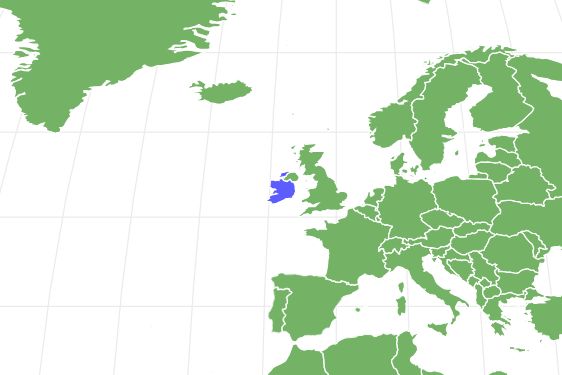Wheaten Terrier
Canis lupus
Originally bred as a farm dog, the Wheaten Terrier can be very protective of its domain.
Advertisement
Wheaten Terrier Scientific Classification
- Kingdom
- Animalia
- Phylum
- Chordata
- Class
- Mammalia
- Order
- Carnivora
- Family
- Canidae
- Genus
- Canis
- Scientific Name
- Canis lupus
Read our Complete Guide to Classification of Animals.
Wheaten Terrier Conservation Status
Wheaten Terrier Facts
- Fun Fact
- Originally bred as a farm dog, the Wheaten Terrier can be very protective of its domain.
- Temperament
- Friendly, alert, and loyal
- Diet
- Omnivore
Wheaten Terrier as a Pet:
- General Health
- Energy Level
- Shedability
- Trainability
- Intelligence
- Tendency to Chew
- Size
- Family and kid friendliness
- Yappiness / Barking
- Moderate
- Hypoallergenic
- Yes
- Separation Anxiety
- High
- Preferred Temperature
- Average climate
- Exercise Needs
- High
- Friendly With Other Dogs
- High
- Pure bred cost to own
- $900 to $1,500 on average
- Dog group
- Terrier
- Male weight
- 35-40 lbs
- Female weight
- 30-35 lbs
This post may contain affiliate links to our partners like Chewy, Amazon, and others. Purchasing through these helps us further the A-Z Animals mission to educate about the world's species.
View all of the Wheaten Terrier images!
The Wheaten Terrier was once known as the “poor man’s Wolfhound.”
The Wheaten Terrier is a small but long-legged terrier with an unusually soft, silky, and wavy coat. As the name implies, this coat is characterized by a pale yellow wheat-like color, ranging from beige to golden. The long facial hair, which nearly obscures the eyes, has a distinctive and iconic shaggy appearance. There are generally two variants of the Wheaten Terrier: the Irish coat and the heavy (or American) coat. The Irish coat tends to be softer and wavier, while the heavy coat tends to be thicker and fuller. It is possible to create a heavy Irish coat by cross-breeding the two together.
See all of our expert product reviews.
Evolution And History
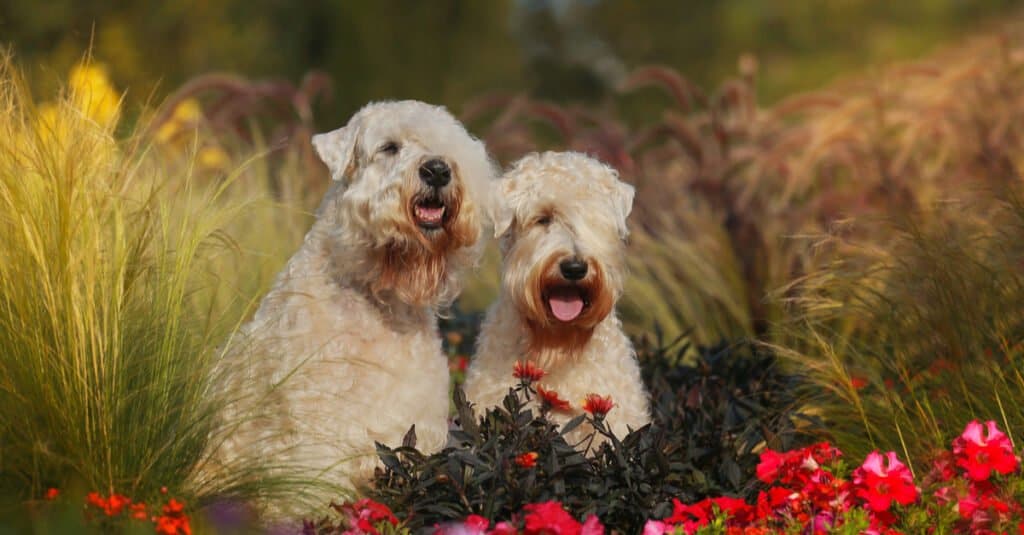
Soft-Coated Wheaten terriers are one of the oldest terrier breeds.
©SubertT/Shutterstock.com
The Wheaten Terrier, also known as the Soft Coated Wheaten Terrier, is one of three breeds of terrier originating from Ireland. This breed can be traced back at least 200 years and it is believed that it is the ancestor of the Kerry Blue and Irish Terriers. There is even an old folktale that says after the defeat of the Spanish Armada in 1588, a dog swam to the Irish shores from the sinking ship and bred with native terriers to parent the Wheaten terrier.
Its original purpose was to be an all-around versatile farm dog that could hunt vermin, protect the chicken coop, and herd animals. This breed was particularly popular among the common farmers, who were restricted by law from owning hounds or beagles. As the purpose of a farm dog steadily declined, the Wheaten Terrier eventually morphed into more of a pet and companion.
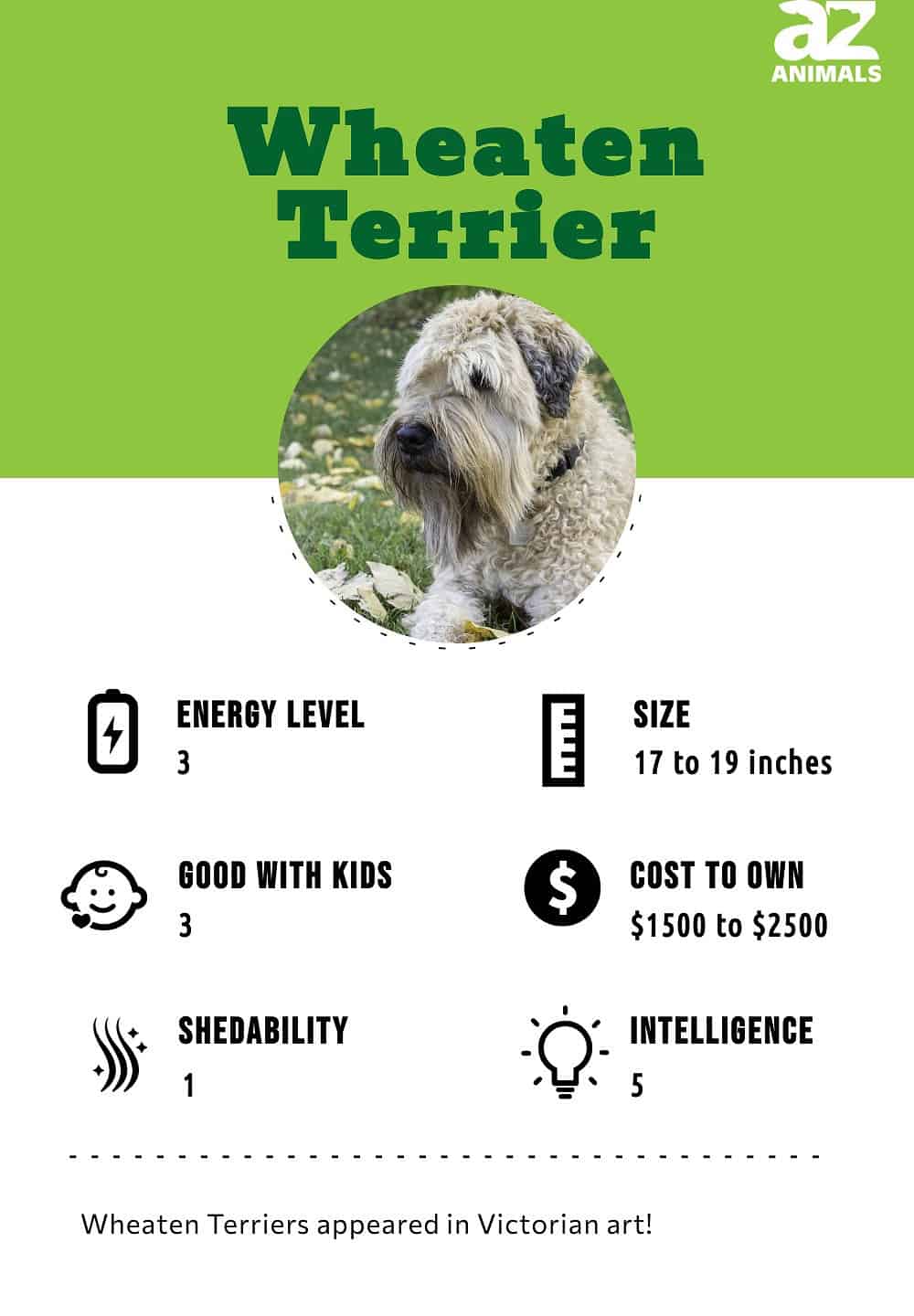
3 Pros And Cons Of Owning A Wheaten Terrier
| Pros! | Cons! |
|---|---|
| Friendly and Affable The Wheaten Terrier is very outgoing and expressive. | Strong Prey Drive The Wheaten Terrier has a tendency to chase smaller animals. |
| Devoted and Loyal This dog is very protective of its owner. | Stubbornness This dog needs a firm but friendly hand to guide it. |
| Energetic and Playful This breed loves to interact with people through playtime and exercise. | High Maintenance Coat The dog’s soft, silky coat requires quite a lot of grooming. |

The Wheaten Terrier loves to interact with people through exercise.
Health and Entertainment for your Wheaten Terrier
- The Best Wet Food for Senior Dogs
- The Best Dog Food for Labrador Retrievers (Senior, Puppy, and Adult)
- These Are the Best Probiotics for Dogs (They Actually Work)
- Victor Senior Healthy Weight Dog Food Review: Recalls, Pros, Cons, and More
- The Best Dog Food for Small Dogs (Puppy, Adult, Senior): Ranked and Reviewed
See all of our expert product reviews.
©Vadim Petrakov/Shutterstock.com
Size And Weight
The Wheaten Terrier is a small to medium size dog with long legs and a slim physique. Males tend to be a fair amount larger than females on average.
| Height (Male) | 18 to 19 inches |
| Height (Female) | 17 to 18 inches |
| Weight (Male) | 35 to 40 pounds |
| Weight (Female) | 30 to 35 pounds |
Common Health Issues

This dog, while generally a very healthy breed, is still prone to certain health conditions and should be taken for regular vet visits.
©Eric Isselee/Shutterstock.com
The Wheaten Terrier is a very healthy breed with a lifespan of some 12 to 14 years, but there is always the chance that it develops some health conditions. The Wheaten may be particularly prone to a developmental kidney disorder called renal dysplasia, which may be particularly serious if it affects both kidneys. Another potential problem is Addison’s disease, meaning the low production of adrenal hormones, which causes poor appetite and loss of energy.
The Wheaten may also have a tendency to develop two little-known conditions called Protein-Losing Nephropathy and Protein-Losing Enteropathy. These conditions cause the dog to lose an excessive amount of protein and plasma from the kidney and gastrointestinal tract, respectively. Other common problems include allergies, cancer, inflammatory bowel disease, and dermatitis. A good breeder should ideally try to reduce the risks for some inheritable diseases. In summation, these are the most common health problems:
- Allergies
- Dermatitis
- Cancer
- Inflammatory Bowel Disease
Temperament
The Wheaten Terrier is a good-natured and well-mannered dog that combines the alert, inquisitive nature of a terrier with the strong drive and work ethic of a working dog. Its friendly and upbeat personality and its tendency to form strong bonds with its owner are all appealing traits of this breed. Owners should be aware that it might have a tendency to develop some destructive behavior if left alone without anything to engage its active mind.
How To Take Care Of The Wheaten Terrier
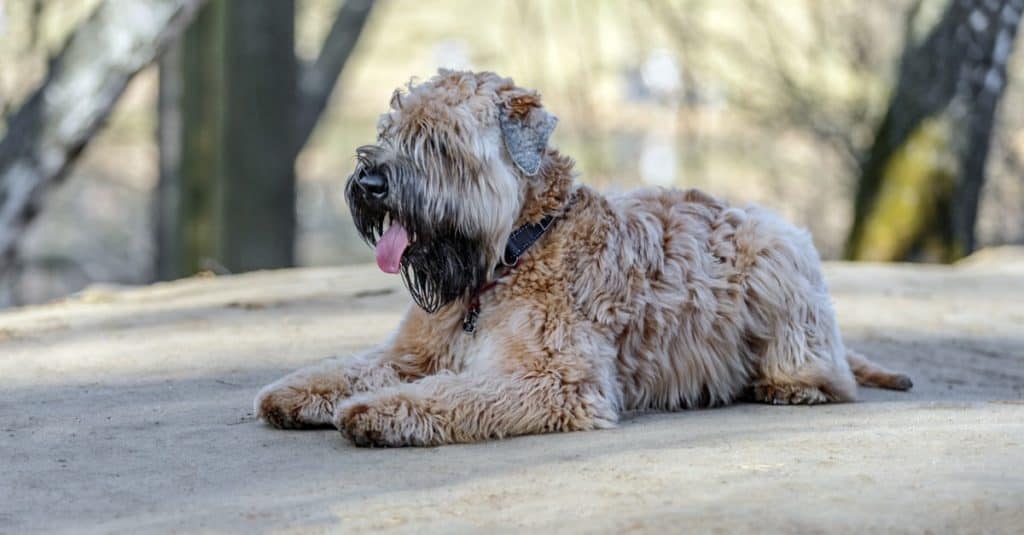
This terrier needs an experienced owner who knows how to handle the breed.
©Vadim Petrakov/Shutterstock.com
Despite its small size, the Wheaten Terrier is actually a real handful to care for. Its constant need for exercise, its high-maintenance coat, and its somewhat stubborn and independent mind all require an engaged and experienced owner who knows how to handle this breed. The Wheaten will also require regular physical examinations at the vet to catch health problems as early as possible. If you have any other questions or concerns about how to take care of your dog, then you should consult with your vet.
The Best Dog Food For Wheaten Terriers
The Soft Coated Wheaten Terrier may need around 1 or 1.5 cups of dog food every day. The exact amount depends on the size, age, and activity level of your dog. It is not a good idea to leave out more food than is necessary for your dog to munch on. This may cause it to gain weight.
Since this breed can suffer from allergies, try to find a limited ingredient or allergy-care dog food that agrees with your Wheaten Terrier.
At A-Z Animals, we feel the best dog food for Wheaten Terriers is Instinct Raw Boost Whole Grain Dry Dog Food, Natural Kibble with Omegas + Freeze-Dried Raw Dog Food.
Made without any corn, wheat, soy, artificial flavors or preservatives, this raw blend offers heightened nutrition for a world of health advantages. The recipe includes lamb, fish, turkey, and beef as less common proteins to avoid food sensitivities, and healthy grains provide fiber plus probiotics for optimum digestion. An abundance of omegas soothes the skin.
Try out Instinct Raw Boost Whole Grain Natural Kibble, available on Chewy and Amazon.
- High protein dog food mixed with freeze dried raw toppers
- Contains probiotics for healthy digestion and omegas for skin & coat
- No corn, wheat, soy, potato, peas, lentils, by-product meal, artificial colors or preservatives.
Maintenance And Grooming
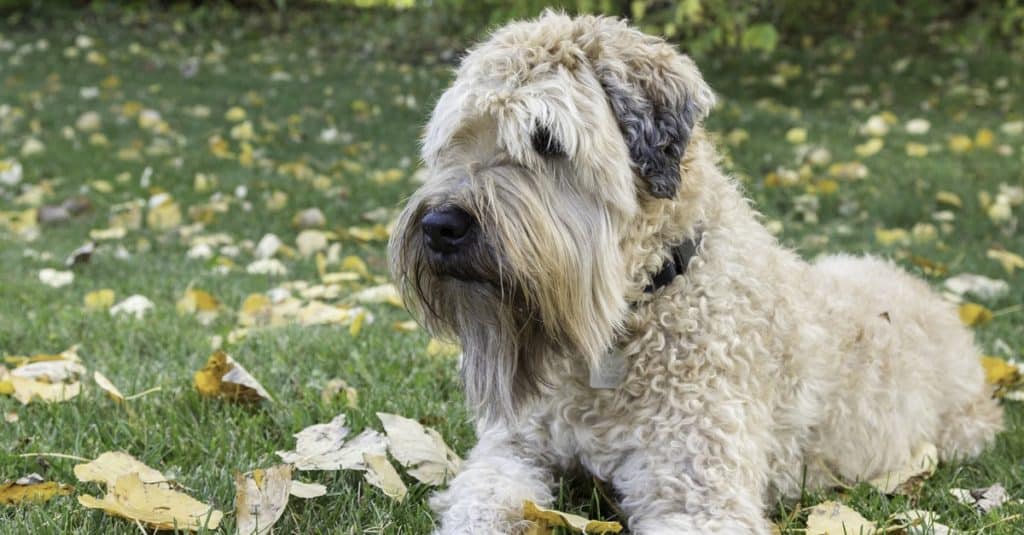
This breed is touted as hypoallergenic because it doesn’t shed but it does require constant cutting.
©C_Gara/Shutterstock.com
The Wheaten Terrier is a dog that doesn’t shed and is touted as hypoallergenic. Nevertheless, their coat still requires meticulous clipping and grooming sessions at least two to three times per week to prevent matting and tangling. These sessions should begin with the use of a pin brush or slick brush to remove the loose dirt and hair. This should be followed with the use of a fine or medium tooth metal comb. Mats need to be pulled apart with the brush, comb, or even the fingers but never with scissors.
Dental hygiene is another important aspect of its regular maintenance routine. The teeth need to be brushed at least two or three times a week with high-quality canine toothpaste. Owners should also trim the nails once or twice a month or whenever they begin to seem uncomfortable. Finally, you should check the ears for wax and debris on a regular basis and clean them out with a cotton swab or ball.
Training
The Wheaten Terrier is an intelligent dog that’s eager to learn and please, but its strong, independent mind might frequently wander off track and get it into trouble. Owners will need to strike a fine balance between being too lax and too harsh. It is necessary to let the dog know who’s in charge without seeming negative or mean, which will just discourage it. This breed should respond very well to positive reinforcement methods such as praise and treats. Owners should also strive to keep the commands consistent but try to vary the routine to make things interesting. If you’re struggling to formulate an effective training method, then there’s no shame in taking your dog to a professional trainer.
Exercise
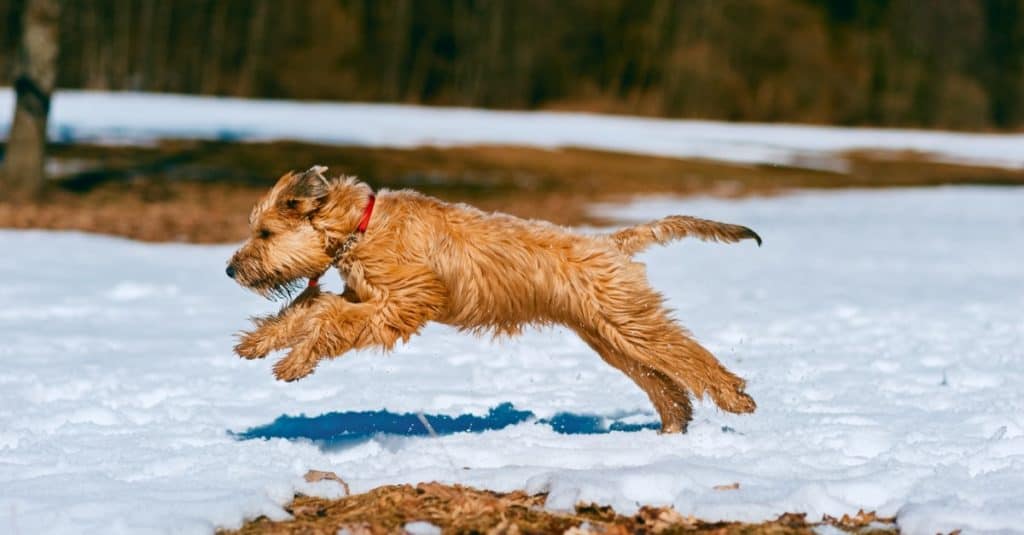
This is a high-energy breed that requires a lot of exercise.
©Alexander Kladov/Shutterstock.com
The Wheaten Terrier is a high-energy dog (even in its older golden years) that requires at least 30 minutes and probably more than an hour of exercise every single day. At least half of this time should be spent on long walks, jogs, or runs. The rest can be devoted to ball games and other playtimes. It is recommended that you have a fenced yard or enclose space nearby in which it can run and play. When you venture out of the yard, you should keep this dog on a leash, because its instincts may take over and cause it to chase after small animals and objects. This dog’s soft, silky coat can also become warm and overheated in the summer, so you should take special care to find shade and rest in particularly hot weather.
Puppies
Wheaten puppies take about two years to fully mature both physically and mentally. They are born with darker fur and only grow their lighter, wavy hair upon reaching maturation. During this time, puppies need to be properly trained and socialized as early as possible. While naturally curious and friendly, the Wheaten will benefit from exposure to unfamiliar people, dogs, and situations so it can become a well-behaved adult.
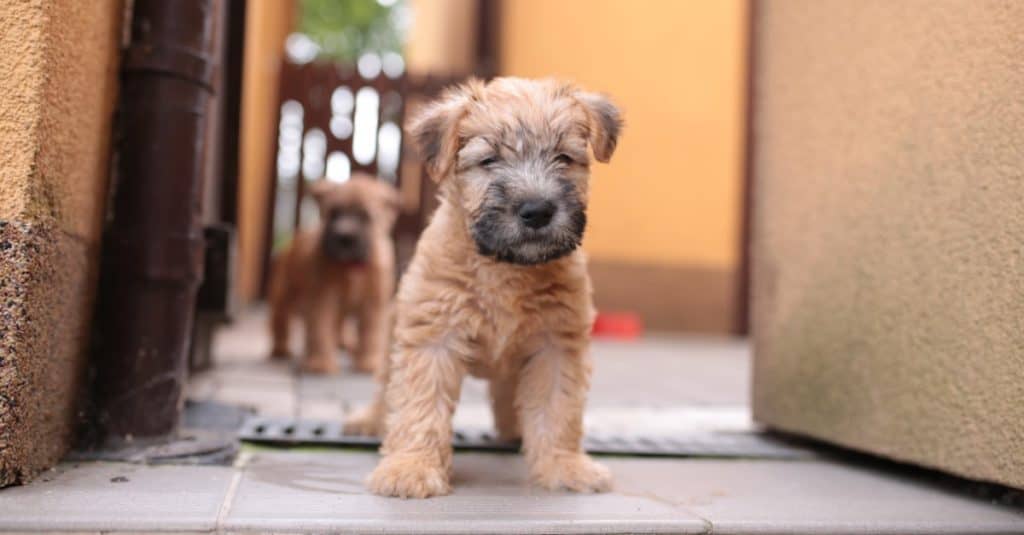
Puppies should be properly trained and socialized as early as possible.
©SubertT/Shutterstock.com
Wheaten Terriers And Children
The Wheaten Terrier is a great family dog. Its playful behavior, friendly and affectionate temperament, and tendency to form strong bonds with its owner should appeal to children of all ages.
Dogs Similar To The Wheaten Terrier
If you are looking for a dog with similar characteristics to the Wheaten Terrier, then you might want to consider one of these Irish dogs:
- Irish Terrier – One of the quintessential Irish breeds, this terrier has a bright red coat, a bold temperament, and a friendly and charismatic personality. Terrier fans will find a lot to love about this breed.
- Kerry Blue Terrier – Originating from the southwestern county of Ireland which bears its name, the Kerry Blue Terrier is an alert, animated, and friendly farm dog turned companion with a light gray or deep blue coat of fur.
- Glen of Imaal Terrier – The gentle but brave Glen of Imaal is a short-legged farm dog with a wheaten or blue-colored coat of fur. It is named for the isolated valley south of Dublin from which the dog originated over the centuries.
Famous Wheaten Terriers
The Wheaten Terrier is still a little bit of an unknown breed outside of its native Ireland, but it has made an impact on the dog show circuit. A Soft Coated Wheaten named Crawford won a best-of-breed prize at the 2019 Westminster Dog Show.
Popular Names For The Wheaten Terrier
If you’re looking for a suitable name for your new Soft Coated Wheaten Terrier, then you may want to consider one of the following options:
- Bella
- Charlie
- Murphy
- Bailey
- Maggie
- Teddy
- Lucy
- Riley
- Cooper
- Molly
Wheaten Terrier FAQs (Frequently Asked Questions)
What is a Wheaten Terrier?
The Wheaten Terrier is a small energetic and friendly pet, originally bred as a farm dog, with a silky, light shedding hypoallergenic coat of white to golden fur. It has an average lifespan between 12 and 14 years.
How much does a Wheaten terrier cost?
The price of buying a newborn puppy from a high-quality breeder is usually between $900 and $1,500. While this may seem expensive, good breeders will take many precautions to ensure their dogs are in excellent health, which will save you money and heartache in the long run. If price is a concern, then you might want to consider adopting a dog from a shelter or rescue, which will usually cost a few hundred dollars. Some rescue groups are devoted specifically to the rehabilitation of this breed and will provide owners with the tools they need to bring home a happy, healthy dog. Rescue groups only operate in select states, however.
How do you groom a Wheaten Terrier?
The Wheaten needs to be brushed two to three times a week, first with a pin brush and then a metal comb.
Do Wheaten Terriers bark a lot?
The Wheaten Terrier is not a chronic barker, but it may make an alarm call if it hears something suspicious and unfamiliar around the home.
Do Wheaten Terriers like to cuddle?
The Wheaten does enjoy plenty of human contact, but owners should be aware that this is not a lap dog.
Can Wheaten Terriers be left alone?
The Wheaten Terrier does have a tendency to become bored and destructive without any human interactions or activities to do. Ideally, there should always be someone around to keep it company.
Are Wheatens good family dogs?
Yes, the Wheaten is an excellent family dog. It has a good reputation with children.
What are some types of mixed Wheaten Terriers?
There are almost endless combinations with this breed. To name just a few, the Wheaten can be mixed with the Kerry Blue Terrier to produce the Kerry Wheaten. It can also be mixed with the Labrador Retriever to form the Wheatedor.
What are the differences between Whoodles and Wheaten Terrier?
The main differences between a Whoodle and a Wheaten Terrier are that Whoodles are hybrids while Wheatens are purebred, Whoodles are “hypoallergenic,” and Whoodles can be larger or smaller, depending on the poodle parents.
Thank you for reading! Have some feedback for us? Contact the AZ Animals editorial team.
Sources
- American Kennel Club, Available here: https://www.akc.org/dog-breeds/soft-coated-wheaten-terrier/
- American Kennel Club, Available here: https://www.akc.org/expert-advice/lifestyle/soft-coated-wheaten-terrier-facts/
- American Kennel Club, Available here: https://www.akc.org/expert-advice/dog-breeds/soft-coated-wheaten-terrier-history-ireland/

